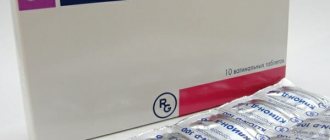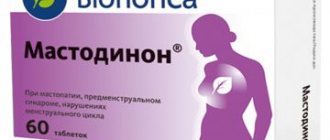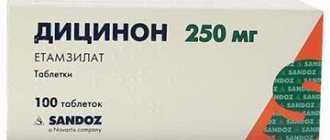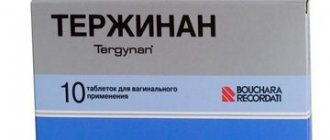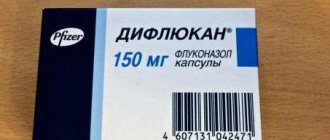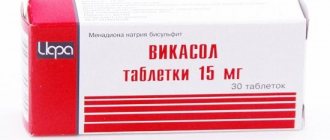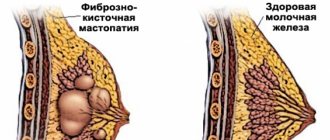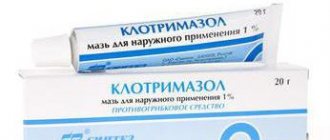- July 22, 2020
- obstetrics and gynecology
- Dana
"Vikasol" is produced in several forms, the most common and effective is an injection solution. This medication is used for various types of bleeding. And, judging by the reviews, it copes with its function very successfully.
The instructions for using Vikasol in ampoules indicate that the main active ingredient in the medication is menadione sodium bisulfate. 1 ml of solution contains 10 mg of active substance. Additional components of the drug include sodium metabisulfate, hydrochloric acid and water for injection.
The instructions for using Vikasol in ampoules state that the shelf life of the drug is 2 years. The optimal temperature is from 2 to 8 °C. The active substance instantly disintegrates when exposed to sunlight.
The drug is available with a prescription. There is 1 ml in 1 ampoule, 5 ampoules in a blister pack, 2 ampoules in a box. The medication must be hidden from children.
If we talk about the pharmacotherapeutic group, then Vikasol injections contain vitamin K and other hemostatic agents.
Pharmacodynamics
So, the drug is based on vitamin K. It has several forms. The main one, K1, is found in plants, in particular, in green leafy vegetables. The second common form, K2 or menaquinone, is absorbed only in a certain amount. Produced by bacteria in the lower part of the small intestine, as well as in the large intestine.
The drug is a synthetic analogue of vitamin K and is considered vitamin K3. It promotes the synthesis of prothrombin and proconvertin, increases blood clotting. Has a hemostatic effect. When there is a lack of vitamin K in the body, bleeding increases.
The importance of vitamin K for humans and animals does not lie only in its effect on the synthesis of procoagulants. It exhibits bioenergetic effects and several anabolic actions. A lack of vitamin leads to a lack of adenosine triphosphate and a decrease in the energy capacity of the biosynthesis of many compounds. The latter include not only procoagulants, but also other rapidly renewed proteins, including several enzymes that are not directly related to the course of blood coagulation.
With a lack of vitamin K, the synthesis of certain biologically active non-protein elements is also weakened: serotonin, histamine, acetylcholine. The onset of the effect is 8-24 hours after intramuscular administration.
Indications and contraindications
There are a large number of indications for the use of the product. The list of these diseases includes all those in which the blood coagulation system is disrupted, as well as the prevention of complications of certain diseases:
- Hypo- or avitaminosis of vitamin K, including secondary conditions in which there is a lack of internal synthesis of vitamins (hepatitis).
- Peptic ulcer of the stomach and duodenum, their perforation, Crohn's disease.
- Prolonged nosebleeds.
- Prolonged uterine bleeding (hypermenorrhea).
- Stopping bleeding in the 3rd trimester of pregnancy (only under medical supervision).
- Prevention of bleeding in newborns.
- Radiation sickness.
- Compensation for the effect of anticoagulants.
- Preoperative period.
Despite the fact that this is a vitamin preparation, it has a number of contraindications. They include not only refusal of treatment with Vikasol, but also a diet with a low vitamin K content.
Contraindications include the following conditions and diseases:
- hypercoagulability syndrome (increased tendency to blood clotting);
- thromboembolism;
- jaundice of newborns;
- individual intolerance to the drug.
Pharmacokinetics
After administration, the drug quickly and easily enters the bloodstream. The nature of binding to plasma proteins is reversible. The blood of patients with a small amount of albumin binds the vitamin poorly or does not do so at all.
Accumulates in the myocardium, spleen and liver. The most active process occurs in the myocardium and skeletal muscles. The weakest is in the kidneys. It is excreted from the body via the kidneys and bile in the form of metabolites.
A third of the metabolites are excreted in human urine in the form of monosulfate, phosphate, and diglucuronide-2-methyl-1,4-naphthoquinone. The high proportion in human excrement is due to the fact that it is synthesized by intestinal microflora.
Indications
The instructions for use of "Vikasol" in ampoules indicate that it is prescribed for intense bleeding and hypoprothrombinemia, which is caused by jaundice, for hepatitis of various etiologies, parenchymal and capillary bleeding.
Vikasol injections are prescribed after surgery or wounds, for bleeding due to stomach and duodenal ulcers, intense signs of radiation sickness in the acute stage, regular nosebleeds and hemorrhoids.
Doctors often prescribe Vikasol injections to newborns. What are they from? Often, premature babies need the drug for hemorrhagic phenomena. It is also prescribed for overdose of phenyline, neodicoumarin and other anticoagulants-vitamin K agonists.
For uterine bleeding, Vikasol is most often prescribed. But, in addition, it is used for spontaneous bleeding, before preparing for surgery, for pulmonary hemorrhages, and bleeding due to septic diseases.
Vitamins Pharmstandard VIKASOL - reviews
Warning!!!
This review is based personally on my experience using this drug.
.
I do not guarantee that you will not experience complications after using it. All dosages and methods of use recommended in this review are suitable for me personally
.
I do not guarantee that they will be effective and safe for you! Before use, be sure to read the instructions and ask your doctor for advice. Health is not a toy!
Probably all the girls will agree with me that “these very days” always come at the most inopportune moment. I am no exception. At one time, I crawled around a bunch of forums, looking for a means to “delay” or, conversely, speed up the process. As much as I tormented myself, I even drank milk with iodine. But this did not bring any special results. That’s when I learned about the product Vikasol, which to this day is my faithful assistant.
The main active component of the drug is synthetic water-soluble vitamin K. That is, the effect of Vikasol is based on improving blood clotting. See full summary below.
I won’t beat around the bush - the drug really helps!
It’s just very important to keep the dose. For me personally, the exact dosage is one tablet no more than once every 6 hours. If you take more, there will be no improvement in the effect or an increase in the duration of action, but you will receive an unpleasant “bonus” in the form of a dull pain in the lower abdomen.
However, nothing disappears forever. So, be prepared for the fact that the retained blood will still “flow out” in full, but in a shorter period of time.
The cost of one pack is 16-20 rubles.
One pack contains 20 tablets.
Personally, I recommend taking these pills only when absolutely necessary.
and the time of use should not exceed two days, because the body is a self-regulating system, interference with which is fraught and no one knows what effect will come from taking these pills. As you can see, in three years I haven’t used even half a pack.
The pack has a long shelf life, I bought it 3 years ago and still have 1 year in “stock”.
And finally, an excerpt from an article from a medical forum.
Most often, when there is a delay, in order to induce menstruation, Duphaston, Pulsatill and regular contraceptive pills are taken. These are unsafe drugs, but they are acceptable for use, provided that their use is approved by a doctor.
You can induce menstruation by taking Duphaston after a 5-day course of taking 2 tablets per day. Abrupt withdrawal of the drug causes menstruation.
Pulsatill is a strong drug for inducing menstruation. The effect of taking it appears within a few hours. The standard dosage is 7 granules.
Oral cyclic contraceptives also help induce periods. As with taking Duphaston, sudden withdrawal of hormonal pills provokes menstruation. You can stop taking birth control pills as soon as the package runs out or at any other time during your cycle.
Despite the fact that all means for inducing menstruation after a delay are medications and are used in gynecology, it is unacceptable to use them regularly and without consulting a gynecologist. It is also unacceptable to use such pseudo-folk methods of inducing menstruation as ascorbic acid, tansy tincture, iodine with milk and the drug Postinor.
Folk remedies that are used for delayed periods
Personally, I have not tried these methods, but I consider it necessary to write about them.
Folk remedies used to induce menstruation confidently lead in the popularity rating among all others. It just so happens that subconsciously, herbal infusions are perceived as completely harmless and even healthy drinks. Therefore, taking herbs is often equated to drinking tea and is carried out uncontrollably.
- Mix mint herb, valerian root, chamomile. Add 200 hot water. The mixture is infused for 15-20 minutes, filtered, squeezed and drunk half a glass with breakfast and dinner.
- Pour boiling water and leave in a thermos for 12 hours a mixture of rose hips, elecampane, Rhodiola rosea, knotweed, nettle, oregano and 1 liter of boiling water. In order to induce menstruation, the filtered infusion is taken all day, half a glass per dose.
Interaction with other drugs
Using the drug together with oral anticoagulants reduces the anticoagulant effect. It reduces the effect of indirect anticoagulants. Does not affect the activity of heparin in any way. The use of the drug in combination with antibiotics requires an increase in the dose of vitamin K.
Concomitant use with hemolytic drugs increases the risk of secondary effects.
The drug is not compatible with medications based on sulfonamides, PAS, salicialates and oxycoumarins. It is prohibited to add solutions of acids and alkalis to one injection.
Side effects
Undesirable consequences of taking the drug include:
- Allergic reaction. Manifests itself in the form of urticaria, erythema, runny nose, skin rashes with itching. Bronchospasm may occur.
- An excess of vitamin K in the body is hypervitaminosis. As a result, the level of clotting factors (prothrombin and thrombin) and bilirubin increases in the blood.
- Reduced blood pressure.
- Dizziness, weakness.
- Nausea.
In childhood, Vikasol can cause poisoning, which manifests itself as convulsions.
Contraindications and application features
You should not take the drug if you have increased blood clotting (viscous blood) or thromboembolism (when blood vessels are blocked by blood clots).
If the outflow of bile is impaired, administer the drug only by injection.
Vikasol has no effect in hemophilia and Werlhoff and von Willebrand diseases.
The drug is used with caution and under medical supervision for liver failure and 6-phosphate dehydrogenase deficiency.
For quick action, it is better to use the drug in the form of injections.
Vikasol is not recommended for bronchial asthma. The risk of exacerbation of the disease and the occurrence of edema increases.
The drug does not affect the reaction rate and is not a contraindication to working with machinery. But sometimes, while taking the drug, dizziness was observed. In such cases, you need to change the drug or refrain from potentially hazardous activities.
During pregnancy
Vikasol can be taken during pregnancy and lactation, but only as prescribed by a doctor. Which will correlate and evaluate the risks and benefits of the drug.
Overdose
If you take a large dose of the drug, vitamin K hypervitaminosis and general poisoning of the body may develop.
Manifestations:
- Stool upset, abdominal pain;
- Excited state.
- Allergic reaction: skin rash, runny nose, bronchospasm.
- Cramps.
- You need to seek medical help and take anticoagulants to reduce blood viscosity.
Use during pregnancy and lactation
Doctors do not recommend using Vikasol during pregnancy. In the first two trimesters, use is allowed only if it is necessary according to indications, namely: the benefits for the pregnant woman outweigh the risks for the fetus.
The drug is not prescribed in the third trimester of pregnancy. At this stage, it is ineffective due to its rather weak permeability through the placenta.
If a medication is prescribed during lactation, then breastfeeding should be abandoned so as not to harm the baby.
Directions for use and doses
Many people are interested in whether the Vikasol injection is painful or not. The drug is administered intramuscularly, and it is quite painful. Therefore, you should be patient. A single dose for an adult is 10 mg. The maximum allowed dose is 15 mg at a time, and 30 mg per day.
Therapy lasts 3-4 days. Then they take a break equal to the number of days of therapy. If necessary, the course is repeated.
Before surgery with the likelihood of severe parenchymal bleeding, the drug is prescribed 2-3 days in advance.
Used during menstruation - instructions for using Vikasol in ampoules include this information. But it is up to the doctor to determine whether a woman needs this drug. Moreover, those who are afraid of pain should think carefully about it.
Instructions for use during menstruation
Vikasol tablets can be used to stop menstruation. The use of intramuscular injections is not the most popular method. It requires certain skills and is not always convenient. In case of heavy periods, only a doctor can prescribe Vikasol; during the course of treatment, it is necessary to donate blood for a coagulogram to prevent complications.
In gynecology, Vikasol is used in the following cases:
- Dysfunctional uterine bleeding.
- Endometritis and endometriosis. In this case, Vikasol is not the main treatment and is prescribed as an adjuvant therapy.
- Prolonged, continuous bleeding after abortion.
Uncontrolled and unjustified use during menstruation can lead to serious disorders of reproductive function, as well as have a systemic effect on the entire body, leading to coagulopathies, causing allergic reactions and a persistent increase in blood pressure.
The permissible dose of the drug should not be exceeded if Vikasol is used to stop menstruation. The maximum dose for a single dose is 30 mg, that is, 2 tablets, and the daily dose is 60 mg. The recommended amount is 1-2 tablets per day, while the course is only 2 days.
Adverse reactions
Adverse reactions include the following:
- hyperbilirubinemia;
- jaundice (both in adults and small children);
- low blood pressure;
- weak pulse;
- tachycardia;
- anemia;
- hemolysis in infants who were born with a deficiency of glucose-6-phosphate dehydrogenase, or in people who have insufficient amounts of vitamin E;
- thromboembolism;
- rash and itching;
- bronchospasm;
- dizziness;
- intense sweating;
- taste sensations disappear;
- pain at the injection site;
- changes in the color of a person’s skin due to the body not accepting injections.
The drug provokes local scleroderma.
